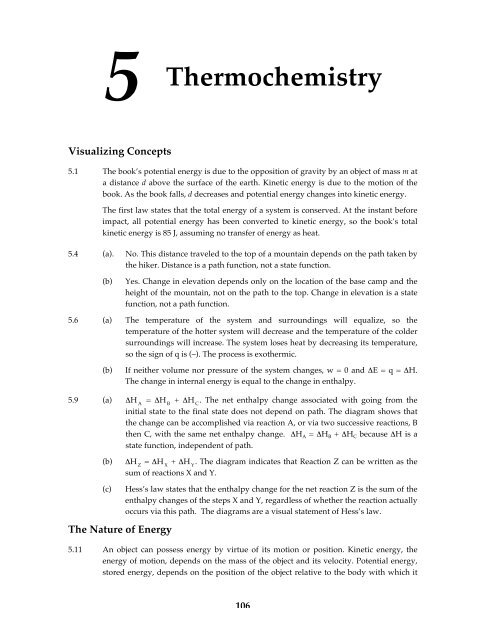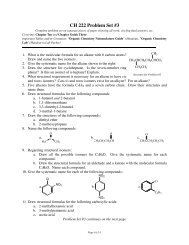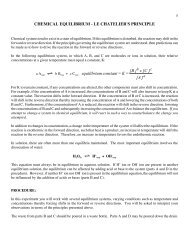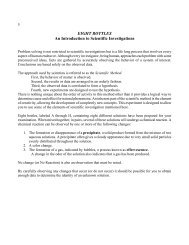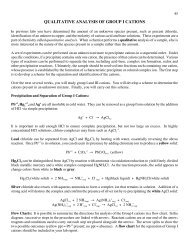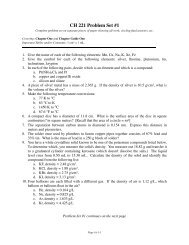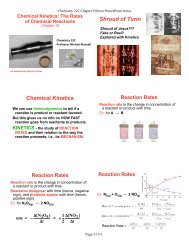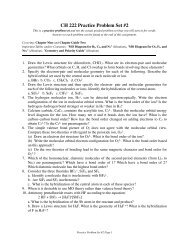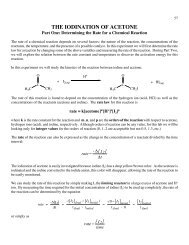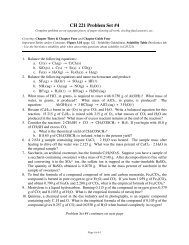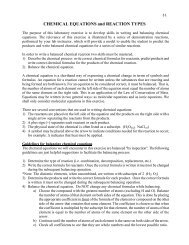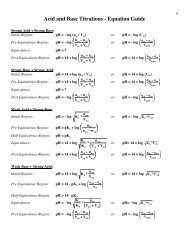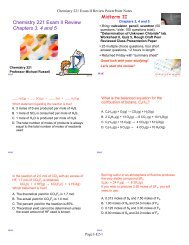5 Thermochemistry
5 Thermochemistry
5 Thermochemistry
You also want an ePaper? Increase the reach of your titles
YUMPU automatically turns print PDFs into web optimized ePapers that Google loves.
5 <strong>Thermochemistry</strong><br />
Visualizing Concepts<br />
5.1 The book’s potential energy is due to the opposition of gravity by an object of mass m at<br />
a distance d above the surface of the earth. Kinetic energy is due to the motion of the<br />
book. As the book falls, d decreases and potential energy changes into kinetic energy.<br />
The first law states that the total energy of a system is conserved. At the instant before<br />
impact, all potential energy has been converted to kinetic energy, so the book’s total<br />
kinetic energy is 85 J, assuming no transfer of energy as heat.<br />
5.4 (a). No. This distance traveled to the top of a mountain depends on the path taken by<br />
the hiker. Distance is a path function, not a state function.<br />
(b)<br />
Yes. Change in elevation depends only on the location of the base camp and the<br />
height of the mountain, not on the path to the top. Change in elevation is a state<br />
function, not a path function.<br />
5.6 (a) The temperature of the system and surroundings will equalize, so the<br />
temperature of the hotter system will decrease and the temperature of the colder<br />
surroundings will increase. The system loses heat by decreasing its temperature,<br />
so the sign of q is (–). The process is exothermic.<br />
(b)<br />
If neither volume nor pressure of the system changes, w = 0 and ΔE = q = ΔH.<br />
The change in internal energy is equal to the change in enthalpy.<br />
5.9 (a) ΔH A<br />
= ΔH B<br />
+ ΔH C<br />
. The net enthalpy change associated with going from the<br />
initial state to the final state does not depend on path. The diagram shows that<br />
the change can be accomplished via reaction A, or via two successive reactions, B<br />
then C, with the same net enthalpy change. ΔH A = ΔH B + ΔH C because ΔH is a<br />
state function, independent of path.<br />
(b)<br />
ΔH Z<br />
= ΔH X<br />
+ ΔH Y<br />
. The diagram indicates that Reaction Z can be written as the<br />
sum of reactions X and Y.<br />
(c)<br />
The Nature of Energy<br />
Hess’s law states that the enthalpy change for the net reaction Z is the sum of the<br />
enthalpy changes of the steps X and Y, regardless of whether the reaction actually<br />
occurs via this path. The diagrams are a visual statement of Hess’s law.<br />
5.11 An object can possess energy by virtue of its motion or position. Kinetic energy, the<br />
energy of motion, depends on the mass of the object and its velocity. Potential energy,<br />
stored energy, depends on the position of the object relative to the body with which it<br />
106
5 <strong>Thermochemistry</strong> Solutions to Exercises<br />
interacts.<br />
5.13 (a) Analyze. Given: mass and speed of ball. Find: kinetic energy.<br />
Plan. Since<br />
convert g → kg to obtain E k<br />
in joules.<br />
Solve.<br />
Check. 1/2(45 × 3600/1000) ≈ 1/2(40 × 4) ≈ 80 J<br />
(b)<br />
(c)<br />
As the ball hits the sand, its speed (and hence its kinetic energy) drops to zero.<br />
Most of the kinetic energy is transferred to the sand, which deforms when the<br />
ball lands. Some energy is released as heat through friction between the ball and<br />
the sand.<br />
5.15 Analyze. Given: heat capacity of Find: J/Btu<br />
Plan.<br />
This strategy requires changing °F to °C. Since this involves the magnitude of a degree<br />
on each scale, rather than a specific temperature, the 32 in the temperature relationship<br />
is not needed. 100 °C = 180 °F; 5 °C = 9 °F<br />
Solve.<br />
5.17 (a) In thermodynamics, the system is the well-defined part of the universe whose<br />
energy changes are being studied.<br />
(b)<br />
A closed system can exchange heat but not mass with its surroundings.<br />
5.19 (a) Work is a force applied over a distance.<br />
(b)<br />
The amount of work done is the magnitude of the force times the distance over<br />
which it is applied. w = F × d.<br />
5.21 (a) Gravity; work is done because the force of gravity is opposed and the pencil is<br />
lifted.<br />
(b)<br />
Mechanical force; work is done because the force of the coiled spring is opposed<br />
as the spring is compressed over a distance.<br />
The First Law of Thermodynamics<br />
5.23 (a) In any chemical or physical change, energy can be neither created nor destroyed,<br />
but it can be changed in form.<br />
(b)<br />
The total internal energy (E) of a system is the sum of all the kinetic and potential<br />
energies of the system components.<br />
107
5 <strong>Thermochemistry</strong> Solutions to Exercises<br />
(c)<br />
The internal energy of a closed system (where no mass exchange with<br />
surroundings occurs) increases when work is done on the system by the<br />
surroundings and/or when heat is transferred to the system from the<br />
surroundings (the system is heated).<br />
5.25 Analyze. Given: heat and work. Find: magnitude and sign of ΔE.<br />
Plan. In each case, evaluate q and w in the expression ΔE = q + w. For an exothermic<br />
process, q is negative; for an endothermic process, q is positive. Solve.<br />
(a)<br />
(b)<br />
(c)<br />
q is positive because the system absorbs heat and w is negative because the<br />
system does work. ΔE = 105 kJ – 29 kJ = 76 kJ. The process is endothermic.<br />
ΔE = 1.50 kJ – 657 J = 1.50 kJ – 0.657 kJ = 0.843 = 0.84 kJ. The process is<br />
endothermic.<br />
q is negative because the system releases heat, and w is negative because the<br />
system does work. ΔE = –57.5 kJ – 22.5 kJ = –80.0 kJ. The process is exothermic.<br />
5.27 Analyze. How do the different physical situations (cases) affect the changes to heat and<br />
work of the system upon addition of 100 J of energy?<br />
Plan. Use the definitions of heat and work and the First Law to answer the questions.<br />
Solve. If the piston is allowed to move, case (1), the heated gas will expand and push<br />
the piston up, doing work on the surroundings. If the piston is fixed, case (2), most of<br />
the electrical energy will be manifested as an increase in heat of the system.<br />
(a)<br />
(b)<br />
(c)<br />
Since little or no work is done by the system in case (2), the gas will absorb most<br />
of the energy as heat; the case (2) gas will have the higher temperature.<br />
In case (2), w ≈ 0 and q ≈ 100 J. In case (1), a significant amount of energy will be<br />
used to do work on the surroundings (–w), but some will be absorbed as heat<br />
(+q). (The transfer of electrical energy into work is never completely efficient!)<br />
ΔE is greater for case (2), because the entire 100 J increases the internal energy of<br />
the system, rather than a part of the energy doing work on the surroundings.<br />
5.29 (a) A state function is a property of a system that depends only on the physical state<br />
(pressure, temperature, etc.) of the system, not on the route used by the system to<br />
get to the current state.<br />
(b)<br />
(c)<br />
Internal energy and enthalpy are state functions; heat is not a state function.<br />
Work is not a state function. The amount of work required to move from state A<br />
to state B depends on the path or series of processes used to accomplish the<br />
change.<br />
Enthalpy<br />
5.31 (a) Change in enthalpy (ΔH) is usually easier to measure than change in internal<br />
energy (ΔE) because, at constant pressure, ΔH = q. The heat flow associated with<br />
a process at constant pressure can easily be measured as a change in temperature.<br />
Measuring ΔE requires a means to measure both q and w.<br />
108
5 <strong>Thermochemistry</strong> Solutions to Exercises<br />
(b)<br />
If ΔH is negative, the enthalpy of the system decreases and the process is<br />
exothermic.<br />
5.33 At constant pressure, ΔE = ΔH – PΔV. In order to calculate ΔE, more information about<br />
the conditions of the reaction must be known. For an ideal gas at constant pressure and<br />
temperature, PΔV = RTΔn. The values of either P and ΔV or T and Δn must be known to<br />
calculate ΔE from ΔH.<br />
5.35 Analyze/Plan. q = –79 kJ (heat is given off by the system), w = –18 kJ (work is done by<br />
the system). Solve.<br />
ΔE = q + w = –79 kJ – 18 kJ = –97 kJ. ΔH = q = –79 kJ (at constant pressure).<br />
Check. The reaction is exothermic.<br />
5.37 (a) CH 3 COOH(l) + 2O 2<br />
(g) → 2H 2<br />
O(l) + 2CO 2<br />
(g) ΔH = – 871.7 kJ<br />
(b)<br />
Analyze. How are reactants and products<br />
arranged on an enthalpy diagram?<br />
Plan. The substances (reactants or products,<br />
collectively) with higher enthalpy are shown on<br />
the upper level, and those with lower enthalpy<br />
are shown on the lower level.<br />
Solve. For this reaction, ΔH is negative, so the products have lower enthalpy and<br />
are shown on the lower level; reactants are on the upper level. The arrow points<br />
in the direction of reactants to products and is labeled with the value of ΔH.<br />
5.39 Plan. Consider the sign of ΔH.<br />
Solve. Since ΔH is negative, the reactants, 2Cl(g) have the higher enthalpy.<br />
5.41 Analyze/Plan. Follow the strategy in Sample Exercise 5.4. Solve.<br />
(a)<br />
Exothermic (ΔH is negative)<br />
(b)<br />
Check. The units of kJ are correct for heat. The negative sign indicates heat is<br />
evolved.<br />
(c)<br />
Check. Units are correct for mass. (100 × 2 × 40/1200) ≈ (8000/1200) ≈ 6.5 g<br />
(d) 2MgO(s) → 2Mg(s) + O 2<br />
(g) ΔH = +1204 kJ<br />
This is the reverse of the reaction given above, so the sign of ΔH is reversed.<br />
109
5 <strong>Thermochemistry</strong> Solutions to Exercises<br />
Check. The units are correct for energy. (~9000/80) ≈ 110 kJ)<br />
5.43 Analyze. Given: balanced thermochemical equation, various quantities of substances<br />
and/or enthalpy. Plan. Enthalpy is an extensive property; it is “stoichiometric.” Use the<br />
mole ratios implicit in the balanced thermochemical equation to solve for the desired<br />
quantity. Use molar masses to change mass to moles and vice versa where appropriate.<br />
Solve.<br />
(a)<br />
(b)<br />
Check. Units are correct; sign indicates heat evolved.<br />
(c)<br />
Check. Units correct; sign indicates heat evolved.<br />
Check. Units correct; sign of ΔH reversed; sign indicates heat is absorbed during<br />
the reverse reaction.<br />
5.45 Analyze. Given: balanced thermochemical equation. Plan. Follow the guidelines given<br />
in Section 5.4 for evaluating thermochemical equations. Solve.<br />
(a)<br />
When a chemical equation is reversed, the sign of ΔH is reversed.<br />
CO 2<br />
(g) + 2H 2<br />
O(l) → CH 3<br />
OH(l) + 3/2 O 2<br />
(g)<br />
ΔH = 726.5 kJ<br />
(b)<br />
Enthalpy is extensive. If the coefficients in the chemical equation are multiplied<br />
by 2 to obtain all integer coefficients, the enthalpy change is also multiplied by 2.<br />
2CH 3<br />
OH(l) + 3O 2<br />
(g) → 2CO 2<br />
(g) + 4H 2<br />
O(l)<br />
ΔH = 2(–726.5) kJ = –1453 kJ<br />
(c)<br />
(d)<br />
The exothermic forward reaction is more likely to be thermodynamically favored.<br />
Vaporization (liquid → gas) is endothermic. If the product were H 2<br />
O(g), the<br />
reaction would be more endothermic and would have a smaller negative ΔH.<br />
(Depending on temperature, the enthalpy of vaporization for 2 mol H 2<br />
O is about<br />
+88 kJ, not large enough to cause the overall reaction to be endothermic.)<br />
Calorimetry<br />
If the reactant is in the higher enthalpy gas phase, the overall ΔH for the reaction<br />
has a smaller positive value.<br />
The specific heat of water to four significant figures,<br />
will be used in many<br />
of the following exercises; temperature units of K and °C will be used interchangeably.<br />
5.47 (a) J/mol-K or J/mol-°C. Heat capacity is the amount of heat in J required to raise<br />
the temperature of an object or a certain amount of substance 1 °C or 1 K. Molar<br />
heat capacity is the heat capacity of one mole of substance.<br />
110
5 <strong>Thermochemistry</strong> Solutions to Exercises<br />
(b)<br />
Specific heat is a particular kind of heat capacity where the<br />
amount of substance is 1 g.<br />
(c)<br />
To calculate heat capacity from specific heat, the mass of the particular piece of<br />
copper pipe must be known.<br />
5.49 Plan. Manipulate the definition of specific heat to solve for the desired quantity, paying<br />
close attention to units. C s = q/(m × Δt).<br />
Solve.<br />
(a)<br />
(b)<br />
(c)<br />
(d)<br />
Check. (10 × 4 × 20) ≈ 800 kJ; the units are correct. Note that the conversion factors<br />
for kg → g and J → kJ cancel. An equally correct form of specific heat would be<br />
5.51 Analyze/Plan. Follow the logic in Sample Exercise 5.5. Solve.<br />
5.53 Analyze. Since the temperature of the water increases, the dissolving process is<br />
exothermic and the sign of ΔH is negative. The heat lost by the NaOH(s) dissolving<br />
equals the heat gained by the solution.<br />
Plan/Solve. Calculate the heat gained by the solution. The temperature change is 47.4 –<br />
23.6 = 23.8°C. The total mass of solution is (100.0 g H 2<br />
O + 9.55 g NaOH) = 109.55<br />
= 109.6 g.<br />
This is the amount of heat lost when 9.55 g of NaOH dissolves.<br />
The heat loss per mole NaOH is<br />
Check. (–11/9 × 40) ≈ –45 kJ; the units and sign are correct.<br />
5.55 Analyze/Plan. Follow the logic in Sample Exercise 5.7. Solve.<br />
q b omb<br />
= –q r xn<br />
; ΔT = 30.57°C – 23.44°C = 7.13°C<br />
111
5 <strong>Thermochemistry</strong> Solutions to Exercises<br />
At constant volume, q v<br />
= ΔE. ΔE and ΔH are very similar.<br />
5.57 Analyze. Given: specific heat and mass of glucose, ΔT for calorimeter. Find: heat<br />
capacity, C, of calorimeter. Plan. All heat from the combustion raises the temperature of<br />
the calorimeter. Calculate heat from combustion of glucose, divide by ΔT for<br />
calorimeter to get kJ/°C. Solve.<br />
(a)<br />
(b)<br />
Qualitatively, assuming the same exact initial conditions in the calorimeter, twice<br />
as much glucose produces twice as much heat, which raises the calorimeter<br />
temperature by twice as many °C. Quantitatively,<br />
Hess’s Law<br />
Check. Units are correct. ΔT is twice as large as in part (a). The result has 3 sig figs,<br />
because the heat capacity of the calorimeter is known to 3 sig figs.<br />
5.59 Hess’s Law is a consequence of the fact that enthalpy is a state function. Since ΔH is<br />
independent of path, we can describe a process by any series of steps that add up to the<br />
overall process and ΔH for the process is the sum of the ΔH values for the steps.<br />
5.61 Analyze/Plan. Follow the logic in Sample Exercise 5.8. Manipulate the equations so that<br />
“unwanted” substances can be canceled from reactants and products. Adjust the<br />
corresponding sign and magnitude of ΔH. Solve.<br />
Check. We have obtained the desired reaction.<br />
5.63 Analyze/Plan. Follow the logic in Sample Exercise 5.9. Manipulate the equations so that<br />
“unwanted” substances can be canceled from reactants and products. Adjust the<br />
corresponding sign and magnitude of ΔH. Solve.<br />
Check. We have obtained the desired reaction.<br />
112
5 <strong>Thermochemistry</strong> Solutions to Exercises<br />
Enthalpies of Formation<br />
5.65 (a) Standard conditions for enthalpy changes are usually P = 1 atm and T = 298 K. For<br />
the purpose of comparison, standard enthalpy changes, ΔHº, are tabulated for<br />
reactions at these conditions.<br />
(b)<br />
Enthalpy of formation, ΔH f<br />
, is the enthalpy change that occurs when a compound<br />
is formed from its component elements.<br />
(c) Standard enthalpy of formation, is the enthalpy change that accompanies<br />
formation of one mole of a substance from elements in their standard states.<br />
5.67 (a) 1/2 N 2<br />
(g) + 3/2 H 2<br />
(g) → NH 3<br />
(g)<br />
(b)<br />
(c)<br />
S(s) + O 2<br />
(g) → SO 2<br />
(g)<br />
Rb(s) + 1/2 Cl 2<br />
(g) + 3/2 O 2<br />
(g) → RbClO 3<br />
(s)<br />
(d)<br />
5.69 Plan. Be careful with coefficients,<br />
states, and signs. Solve.<br />
5.71 Plan. Be careful with coefficients, states<br />
and signs. Solve.<br />
(a)<br />
(b)<br />
(c)<br />
(d)<br />
= 2(–395.2 kJ) – 2(–296.9 kJ) – 0 = –196.6 kJ<br />
= –601.8 kJ + (–285.83 kJ) – (–924.7 kJ) = 37.1 kJ<br />
= 4(–241.82 kJ) + 0 – (9.66 kJ) – 4(0) = –976.94 kJ<br />
= –910.9 kJ + 4(–92.30 kJ) – (–640.1 kJ) – 2(–285.83 kJ) = –68.3 kJ<br />
5.73 Analyze. Given: combustion reaction, enthalpy of combustion, enthalpies of formation<br />
for most reactants and products. Find: enthalpy of formation for acetone.<br />
Plan. Rearrange the expression for enthalpy of reaction to calculate the desired enthalpy<br />
of formation. Solve.<br />
5.75 (a) C 8<br />
H 1 8<br />
(l) + 25/2 O 2<br />
(g) → 8CO 2<br />
(g) + 9H 2<br />
O(g) ΔH° = –5064.9 kJ<br />
113
5 <strong>Thermochemistry</strong> Solutions to Exercises<br />
(b)<br />
(c)<br />
8C(s) + 9H 2<br />
(g) → C 8<br />
H 1 8<br />
(l)<br />
Plan. Follow the logic in Solution 5.73 and 5.74. Solve.<br />
5.77 (a) C 2 H 5 OH(l) + 3O 2 (g) → 2CO 2 (g) + 3H 2 O(g)<br />
(b)<br />
= 2(−393.5 kJ) + 3(−241.82 kJ) − (−277.7 kJ) − 3(0) = −1234.76 = −1234.8 kJ<br />
(c)<br />
Plan. The enthalpy of combustion of ethanol [from part (b)] is −1234.8 kJ/mol.<br />
Change mol to mass using molar mass, then mass to volume using density.<br />
Solve.<br />
Check. (1200/50) ≈ 25; 25 × 800 ≈ 20,000<br />
(d)<br />
Plan. The enthalpy of combustion corresponds to any of the molar amounts in<br />
the equation as written. Production of −1234.76 kJ also produces 2 mol CO 2 . Use<br />
this relationship to calculate mass CO 2 /kJ.<br />
Check. The negative sign associated with enthalpy indicates that energy is<br />
emitted.<br />
Foods and Fuels<br />
5.79 (a) Fuel value is the amount of heat produced when 1 gram of a substance (fuel) is<br />
combusted.<br />
(b)<br />
The fuel value of fats is 9 kcal/g and of carbohydrates is 4 kcal/g. Therefore, 5 g<br />
of fat produce 45 kcal, while 9 g of carbohydrates produce 36 kcal; 5 g of fat are a<br />
greater energy source.<br />
5.81 Plan. Calculate the Cal (kcal) due to each nutritional component of the Campbell’s ®<br />
soup, then sum.<br />
Solve.<br />
114
5 <strong>Thermochemistry</strong> Solutions to Exercises<br />
total energy = 153 kJ + 17 kJ + 266 kJ = 436 or 4 × 10 2 kJ<br />
Check. 100 Cal/serving is a reasonable result; units are correct. The data and the result<br />
have 1 sig fig.<br />
5.83 Plan. g → mol → kJ → Cal Solve.<br />
Check. 60 Cal is a reasonable result for most of the food value in an apple.<br />
5.85 Plan. Use enthalpies of formation to calculate molar heat (enthalpy) of combustion<br />
using Hess’s Law. Use molar mass to calculate heat of combustion per kg of<br />
hydrocarbon. Solve.<br />
Propyne: C 3<br />
H 4<br />
(g) + 4O 2<br />
(g) → 3CO 2<br />
(g) + 2H 2<br />
O(g)<br />
(a) 3(–393.5 kJ) + 2(–241.82 kJ) – (185.4 kJ) – 4(0) = –1849.5<br />
= –1850 kJ/mol C 3<br />
H 4<br />
(b)<br />
Propylene: C 3<br />
H 6<br />
(g) + 9/2 O 2<br />
(g) → 3CO 2<br />
(g) + 3H 2<br />
O(g)<br />
(a) 3(–393.5 kJ) + 3(–241.82 kJ) – (20.4 kJ) – 9/2(0) = –1926.4<br />
= –1926 kJ/mol C 3<br />
H 6<br />
(b)<br />
Propane: C 3<br />
H 8<br />
(g) + 5O 2<br />
(g) → 3CO 2<br />
(g) + 4H 2<br />
O(g)<br />
(a) 3(–393.5 kJ) + 4(–241.82 kJ) – (–103.8 kJ) – 5(0) = –2044.0<br />
= –2044 kJ/mol C 3<br />
H 8<br />
(b)<br />
(c)<br />
Additional Exercises<br />
5.87 (a) mi/hr → m/s<br />
These three substances yield nearly identical quantities of heat per unit mass, but<br />
propane is marginally higher than the other two.<br />
115
5 <strong>Thermochemistry</strong> Solutions to Exercises<br />
(b)<br />
Find the mass of one N 2<br />
molecule in kg.<br />
E k<br />
= 1/2 mv 2 = 1/2 × 4.6518 × 10 – 26 kg × (469.38 m/s) 2<br />
(c)<br />
5.90 Like the combustion of H 2<br />
(g) and O 2<br />
(g) described in Section 5.4, the reaction that<br />
inflates airbags is spontaneous after initiation. Spontaneous reactions are usually<br />
exothermic, –ΔH. The airbag reaction occurs at constant atmospheric pressure, ΔH = q p<br />
;<br />
both are likely to be large and negative. When the bag inflates, work is done by the<br />
system on the surroundings, so the sign of w is negative.<br />
5.93 ΔE = q + w = +38.95 kJ – 2.47 kJ = +36.48 kJ<br />
ΔH = q p<br />
= +38.95 kJ<br />
5.96 (a) Plan. Calculate the total volume of water associated with 0.50 inches rain over an<br />
area of one square mile. Use density to change volume to mass, then apply the<br />
enthalpy change.<br />
Volume = area × height = 1 mi 2 × 0.50 in; for the purpose of sig figs, assume 1 mi 2<br />
is an exact number. Note that there are many equivalent ways to obtain the rain<br />
volume in mL. Solve.<br />
(6.336 × 10 4 ) 2 in 2 × 0.50 in = 2.007 × 10 9 = 2.0 × 10 9 in 3 H 2 O<br />
At 25°C, the density of H 2 O is 0.99707 g/mL<br />
3.292 × 10 10 mL × = 3.282 × 10 10 = 3.3 × 10 10 g H 2 O<br />
3.282 × 10 10 g H 2 O × = 8.014 × 10 10 = 8.0 × 10 10 kJ<br />
8.0 × 10 10 kJ (this is 80 billion kJ!) are released when enough water condenses to<br />
produce 0.50 rainfall over an area of one square mile.<br />
(b) 8.014 × 10 10 kJ × = 1.908 × 10 4 = 1.9 × 10 4 ton dynamite<br />
The energy released by this rainstorm is equivalent to explosion of 19,000 tons of<br />
dynamite.<br />
116
5 <strong>Thermochemistry</strong> Solutions to Exercises<br />
5.100 Plan. Use the heat capacity of H 2<br />
O to calculate the energy required to heat the water.<br />
Use the enthalpy of combustion of CH 4<br />
to calculate the amount of CH 4<br />
needed to<br />
provide this amount of energy, assuming 100% transfer. Assume H 2<br />
O(l) is the product<br />
of combustion at standard conditions. Solve.<br />
CH 4<br />
(g) + 2O 2<br />
(g) → CO 2<br />
(g) + 2H 2<br />
O(l)<br />
= –393.5 kJ + 2(–285.83 kJ) – (–74.8 kJ) – (0) = –890.4 kJ<br />
5.103 (a)<br />
(b)<br />
If, like B 2<br />
H 6<br />
, the combustion of B 5<br />
H 9<br />
produces B 2<br />
O 3<br />
as the boron-containing<br />
product, the heat of combustion of B 5<br />
H 9<br />
in addition to data given in part (a)<br />
would enable calculation of the heat of formation of B 5<br />
H 9<br />
.<br />
The combustion reaction is: B 5<br />
H 9<br />
(l) + 6O 2<br />
(g) → 5/2 B 2<br />
O 3<br />
(s) + 9/2 H 2<br />
O(l)<br />
We need to measure the heat of combustion of B 5<br />
H 9<br />
(l).<br />
5.105 (a) 3C 2<br />
H 2<br />
(g) → C 6<br />
H 6<br />
(l)<br />
(b)<br />
(c)<br />
Since the reaction is exothermic (ΔH is negative), the product, 1 mole of C 6<br />
H 6<br />
(l),<br />
has less enthalpy than the reactants, 3 moles of C 2<br />
H 2<br />
(g).<br />
The fuel value of a substance is the amount of heat (kJ) produced when 1 gram of<br />
the substance is burned. Calculate the molar heat of combustion (kJ/mol) and use<br />
this to find kJ/g of fuel.<br />
C 2<br />
H 2<br />
(g) + 5/2 O 2<br />
(g) → 2CO 2<br />
(g) + H 2<br />
O(l)<br />
= 2(–393.5 kJ) + (–285.83 kJ) – 226.77 kJ – 5/2 (0) = –1299.6 kJ/mol C 2<br />
H 2<br />
117
5 <strong>Thermochemistry</strong> Solutions to Exercises<br />
C 6<br />
H 6<br />
(l) + 15/2 O 2<br />
(g) → 6CO 2<br />
(g) + 3H 2<br />
O(l)<br />
= 6(–393.5 kJ) + 3(–285.83 kJ) – 49.0 kJ – 15/2 (0) = –3267.5 kJ/mol C 6<br />
H 6<br />
5.109 ΔE p<br />
= m g Δh. Be careful with units.<br />
1 Cal = 1 kcal = 4.184 kJ<br />
If all work is used to increase the man’s potential energy, 20 rounds of stair-climbing<br />
will not compensate for one extra order of 245 Cal fries. In fact, more than 58 Cal of<br />
work will be required to climb the stairs, because some energy is required to move<br />
limbs and some energy will be lost as heat (see Solution 5.92).<br />
Integrative Exercises<br />
5.112 (a) CH 4<br />
(g) + 2O 2<br />
(g) → CO 2<br />
(g) + 2H 2<br />
O(l)<br />
= –393.5 kJ + 2(–285.83 kJ) – (–74.8 kJ) – 2(0) = –890.36 = –890.4 kJ/mol CH 4<br />
(b)<br />
1eV = 96.485 kJ/mol<br />
The X-ray has approximately 1000 times more energy than is produced by the<br />
combustion of 1 molecule of CH 4<br />
(g).<br />
5.115 (a)<br />
ΔH° = –446.2 kJ – 285.83 kJ – (–206.6 kJ) – (–469.6 kJ) = –55.8 kJ<br />
118
5 <strong>Thermochemistry</strong> Solutions to Exercises<br />
ΔH° = –407.1 kJ – 285.83 kJ – (–167.2 kJ) – (–469.6 kJ) = –56.1 kJ<br />
= –80.29 kJ – 240.1 kJ – 285.83 kJ – (–132.5 kJ) – (–469.6 kJ) = –4.1 kJ<br />
(b)<br />
(c)<br />
(d)<br />
H + (aq) + OH – (aq) → H 2<br />
O(l) is the net ionic equation for the first two reactions.<br />
NH 4 + (aq) + OH – (aq) → NH 3<br />
(aq) + H 2<br />
O(l)<br />
The ΔH° values for the first two reactions are nearly identical, –55.8 kJ and<br />
–56.1 kJ. The spectator ions by definition do not change during the course of a<br />
reaction, so ΔH° is the enthalpy change for the net ionic equation. Since the first<br />
two reactions have the same net ionic equation, it is not surprising that they have<br />
the same ΔH°.<br />
Strong acids are more likely than weak acids to donate H + . The neutralization of<br />
the two strong acids is energetically favorable, while the third reaction is not.<br />
NH 4 + (aq) is probably a weak acid.<br />
5.117 (a) AgNO 3<br />
(aq) + NaCl(aq) → NaNO 3<br />
(aq) + AgCl(s)<br />
net ionic equation: Ag + (aq) + Cl – (aq) → AgCl(s)<br />
ΔH° = –127.0 kJ – (105.90 kJ) – (–167.2 kJ) = –65.7 kJ<br />
(b)<br />
ΔH° for the complete molecular equation will be the same as ΔH° for the net ionic<br />
equation. Na + (aq) and NO 3 – (aq) are spectator ions; they appear on both sides of<br />
the chemical equation. Since the overall enthalpy change is the enthalpy of the<br />
products minus the enthalpy of the reactants, the contributions of the spectator<br />
ions cancel.<br />
(c)<br />
119


